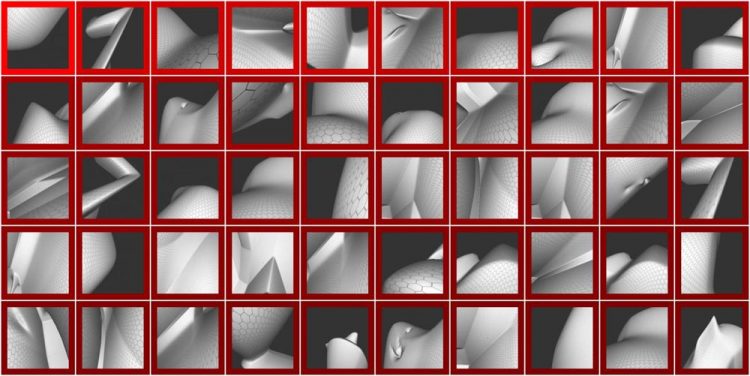Scientists find brain cells that know which end is up

These images used in the study provoked some of the strongest response from neurons that help the rhesus monkeys subjects understand the direction of gravity. Credit: Johns Hopkins University
In a part of the brain responsible for recognizing color, texture and shape, Johns Hopkins University researchers found neurons that used large-scale environmental cues to infer the direction of gravity. The findings, forthcoming this month in the journal Current Biology, and just posted online, suggest these cells help humans orient themselves and predict how objects will behave.
“Gravity is a strong ubiquitous force in our world,” said senior author Charles E. Connor, a professor of neuroscience and director of the university's Zanvyl Krieger Mind/Brain Institute. “Our results show how the direction of gravity can be derived from visual cues, providing critical information about object physics as well as additional cues for maintaining posture and balance.”
Connor, along with lead author Siavash Vaziri, a former Johns Hopkins postdoctoral fellow, studied individual cells in the object area of the rhesus monkey brain, a remarkably close model for the organization and function of human vision. They measured responses of each cell to about 500 abstract three-dimensional shapes presented on a computer monitor. The shapes ranged from small objects to large landscapes and interiors.
They found that a given cell would respond to many different stimuli, especially large planes and sharp, extended edges. What tied these stimuli together was their alignment in the same tilted rectilinear reference frame. These cells, sensitive to different tilts, could provide a continuous signal for the direction of gravity, even as a person constantly moves.
In other words, Connor said, these neurons could help people understand which way is up.
“The world does not appear to rotate when the head tilts left or right or gaze tilts up or down, even though the visual image changes dramatically,” he said. “That perceptual stability must depend on signals like these that provide a constant sense of how the visual environment is oriented.”
The researchers' initial discovery of cells sensitive to large-scale shape, reported in Neuron in 2014, was surprising because they found them in a brain region long regarded as dedicated exclusively to object vision. The new findings make sense of this anatomical juxtaposition, since knowing the gravitational reference frame is critical for predicting how objects will behave.
“When we dive after a ball in tennis, the whole visual world tilts, but we maintain our sense of how the ball will fall and how to aim our next shot,” Connor said. “The visual cortex generates an incredibly rich understanding of object structure, materials, strength, elasticity, balance, and movement potential. These are the things that make us such expert intuitive physicists.”
###
The study was supported by National Institutes of Health grant EY024028.
Media Contact
All latest news from the category: Life Sciences and Chemistry
Articles and reports from the Life Sciences and chemistry area deal with applied and basic research into modern biology, chemistry and human medicine.
Valuable information can be found on a range of life sciences fields including bacteriology, biochemistry, bionics, bioinformatics, biophysics, biotechnology, genetics, geobotany, human biology, marine biology, microbiology, molecular biology, cellular biology, zoology, bioinorganic chemistry, microchemistry and environmental chemistry.
Newest articles

NASA: Mystery of life’s handedness deepens
The mystery of why life uses molecules with specific orientations has deepened with a NASA-funded discovery that RNA — a key molecule thought to have potentially held the instructions for…

What are the effects of historic lithium mining on water quality?
Study reveals low levels of common contaminants but high levels of other elements in waters associated with an abandoned lithium mine. Lithium ore and mining waste from a historic lithium…

Quantum-inspired design boosts efficiency of heat-to-electricity conversion
Rice engineers take unconventional route to improving thermophotovoltaic systems. Researchers at Rice University have found a new way to improve a key element of thermophotovoltaic (TPV) systems, which convert heat…



